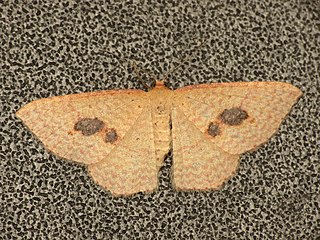
Spilomelinae is a very species-rich subfamily of the lepidopteran family Crambidae, the crambid snout moths. With 4,132 described species in 340 genera worldwide, it is the most speciose group among pyraloids.

Hyalobathra is a genus of moths of the family Crambidae. The genus was erected by Edward Meyrick in 1885.

Epicyme is a monotypic moth genus in the family Geometridae described by Edward Meyrick in 1885. Its only species, Epicyme rubropunctaria, the red-spotted delicate, described by Edward Doubleday in 1843, is found in New Zealand, the Australian Capital Territory, Tasmania and Victoria.
Parapoynx euryscia is a moth in the family Crambidae. It was described by Edward Meyrick in 1885. It is found in Australia, where it has been recorded from Tasmania and Victoria.
Hednota megalarcha is a moth in the family Crambidae. It was described by Edward Meyrick in 1885. It is found in Australia, where it has been recorded from New South Wales.
Hednota panteucha is a moth in the family Crambidae. It was described by Edward Meyrick in 1885. It is found in Australia, where it has been recorded from South Australia and Victoria.
Hyalobathra aequalis is a moth in the family Crambidae. It was described by Julius Lederer in 1863. It is found in south-east Asia.
Hyalobathra crenulata is a moth in the family Crambidae. It was described by Hari Sutrisno and Marianne Horak in 2003. It is found in Australia, where it has been recorded from Queensland.
Hyalobathra dialychna is a moth in the family Crambidae. It was described by Edward Meyrick in 1894. It is found in Myanmar.
Hyalobathra dictatrix is a moth in the family Crambidae. It was described by Edward Meyrick in 1934. It is found in Madagascar, the Comoros and the Democratic Republic of the Congo.
Hyalobathra miniosalis is a moth in the family Crambidae. It was described by Achille Guenée in 1854. It is found in India, Indonesia (Java) and Australia, where it has been recorded from Queensland, the Northern Territory and Victoria.
Hyalobathra paupellalis is a moth in the family Crambidae. It was described by Julius Lederer in 1863. It is found in south-east Asia.
Hyalobathra porphyroxantha is a moth in the family Crambidae. It was described by Edward Meyrick in 1936. It is found in Rwanda.
Eudonia protorthra is a moth in the family Crambidae. It was described by Edward Meyrick in 1885. It is found in Australia, where it has been recorded from New South Wales, Queensland and Victoria.
Trigonoorda trygoda is a moth in the family Crambidae. It was described by Edward Meyrick in 1897. It is found in Australia, where it has been recorded from Queensland, New South Wales and Western Australia.

Glycythyma chrysorycta is a moth in the family Crambidae. It was described by Edward Meyrick in 1884. It is found in India, Sri Lanka, Myanmar, Japan, Korea, China, Taiwan and Australia, where it has been recorded from Queensland.
Herpetogramma platycapna is a moth in the subfamily Spilomelinae of the family Crambidae. It was described by Edward Meyrick in 1897. It is found in Malaysia, Indonesia (Sulawesi), New Guinea, the Keeling Islands and Australia, where it has been recorded from the Northern Territory.
Metasia homophaea is a moth in the family Crambidae. It was described by Edward Meyrick in 1885. It is found in Australia, where it has been recorded from New South Wales.

Nomophilini is a tribe of the species-rich subfamily Spilomelinae in the pyraloid moth family Crambidae. The tribe was erected by Vladimir Ivanovitsch Kuznetzov and Alexandr A. Stekolnikov in 1979.





